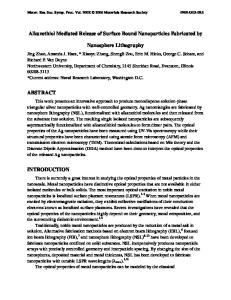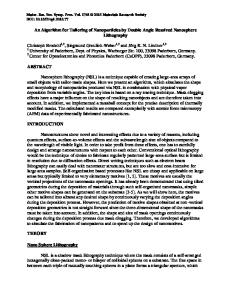Nanostructured Biosensors Produced by Nanosphere Lithography
- PDF / 602,495 Bytes
- 2 Pages / 612 x 792 pts (letter) Page_size
- 35 Downloads / 354 Views
and composition ranges where the α phase is stable. In compositions with 100% α phase, the grain-boundary phase is reduced as all of the additives can enter into the structure. Now, by using a novel stabilizing material, Lu2O3, a team of scientists from the Agency of Industrial Science and Technology (AIST) and the Fine Ceramics Research Association in Nagoya, Japan, have obtained a highly dense, transparent Lu-α-SiAlON ceramic. As reported in the April issue of the Journal of the American Ceramic Society (p. 714), M.I. Jones and K. Hirao of AIST, H. Hyuga of the Fine Ceramics Research Association, and colleagues hot-pressed a mixture of Si3N4, Al2O3, AlN, and Lu2O3 at 1950°C and 40 MPa for 2 h in a 0.9 MPa nitrogen atmosphere. X-ray diffraction patterns of this material showed that only α-SiAlON was present. Both scanning and transmission electron microscopy observations revealed a fully dense, uniform microstructure of equiaxed grains, with a grain size of ~1 µm and with little or no grain-boundary phase present at triple points. Vickers hardness measurements using 98 N load gave results above 19 GPa, and indentation fracture using 98 N
load gave a fracture toughness of ~2.5 MPa m 1/2. Four-point bend tests with inner and outer spans of 10 mm and 30 mm, respectively, and a crosshead speed of 0.5 mm/min gave a bending strength of 400 MPa. Optical transmission measurements using spectrophotometry in the wavelength range of 350–800 nm were performed on 0.5-mm-thick samples. At 350 nm, transmission was ~35%, increasing with increasing wavelength. At ~500 nm, transmission was more than 60%, and for wavelengths larger than 600 nm, transmission was ~70%. Similar measurements reported in the literature on β-SiAlON ceramics gave ~40% transmission maximum at ~4.5 µm wavelength, with low transmission in the visible region. The investigators attribute the high transparency of Lu-α-SiAlON to the lack of grain-boundary phases, lack of porosity, and the small uniform grain size. The investigators said that they will now study the mechanical properties of this material, which are expected to be better than the more commonly studied Y-stabilized SiAlON, at high temperatures. SIARI SOSA
Nanostructured Biosensors Produced by Nanosphere Lithography Biosensors rely on the principle of specific interactions between the sensor support and the biomolecule targeted. Thus, high control over the sensor-surface shape and functionality at the nanoscale is needed. Optical lithography can be used to generate patterned surfaces, but becomes complicated for feature sizes below 200 nm because of diffraction limits. Nanosphere lithography is an alternative method capable of producing nanotopography over large surface areas, as explained by A. Valsesia and a team of researchers at the Institute for Health and Consumer Protection, Ispra, Italy. As reported in Nano Letters (Web release date, May 8), the researchers produced polymeric nanoislands with biospecific chemical functionalities, combining plasma deposition and etching techniques with collo
Data Loading...









